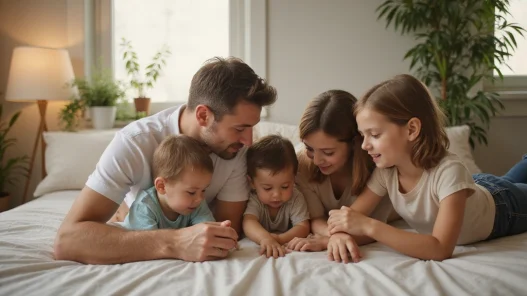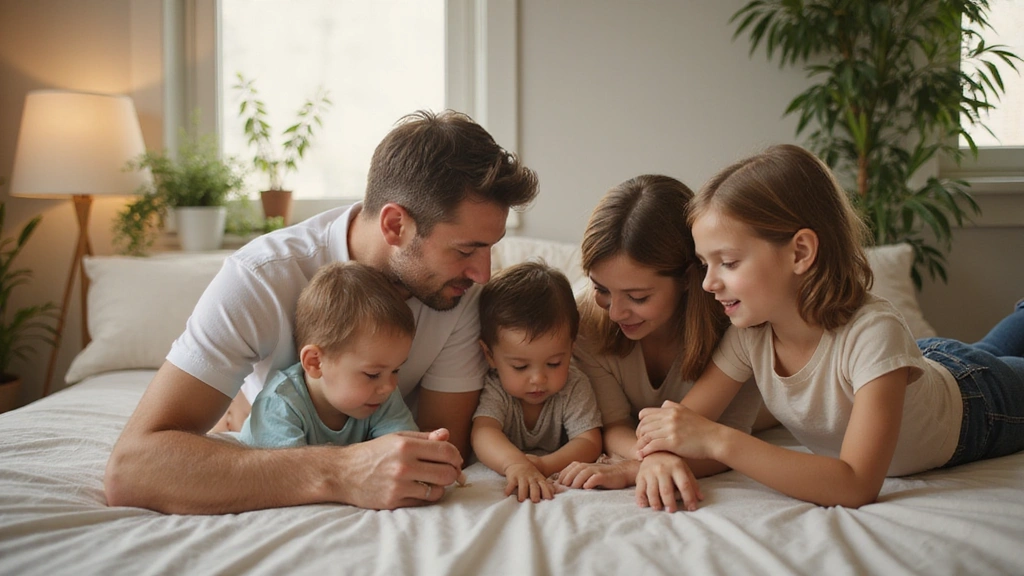Childhood trauma can echo through a person’s life, shaping their emotional health and relationships. As parents, it’s our duty to help our kids navigate through these rough patches, fostering resilience and emotional strength. Healing childhood trauma isn’t just about addressing past pains; it’s about nurturing a brighter future filled with hope, understanding, and love. This journey of healing is as much about connection and communication as it is about practical steps. Whether you’re starting this journey or looking to deepen your efforts, these 14 powerful ways can guide you to create a nurturing environment that promotes healing. Your kids will thank you for this important work.
1. Open the Door to Communication

Creating an open line of communication is crucial for healing childhood trauma. Kids need to feel safe expressing their feelings and thoughts. Start by encouraging them to share their experiences without fear of judgment. You can do this by actively listening and validating their emotions, letting them know it’s okay to feel the way they do.
Cultivating a safe space means being approachable and responsive. When your child talks about their feelings, take time to engage with them thoughtfully. Use open-ended questions to draw them out, such as ‘What made you feel that way?’ or ‘Can you tell me more about it?’
Additionally, modeling your own emotions in a healthy way can teach them that it’s normal to express feelings. This approach not only fosters connection but also lays a foundation for deeper emotional health.
Remember that communication is a two-way street. Be willing to share your own feelings too, as it can normalize their experiences and create a strong bond.
Product Recommendations:
• Emotional Intelligence Workbook for Kids
• The Whole-Brain Child: 12 Revolutionary Strategies to Nurture Your Child’s Developing Mind
• How to Talk So Kids Will Listen & Listen So Kids Will Talk
2. Practice Mindfulness Together

Mindfulness is a powerful tool for managing emotions and healing trauma. Practicing mindfulness as a family can help everyone stay grounded and aware of their feelings. Consider integrating simple mindfulness exercises into your daily routine. This could be as easy as taking a few deep breaths together, going for a nature walk, or trying out guided meditation.
Teach your kids how to focus on the present moment, letting go of worries about the past or future. Activities like mindful coloring or yoga can be fun and engaging ways to introduce mindfulness to younger children.
Incorporating mindfulness into your family life nurtures emotional health, helping kids regulate their feelings better. It encourages them to recognize their emotions, embrace them, and learn coping techniques.
Ultimately, practicing mindfulness together not only aids in healing but strengthens familial bonds through shared experiences.
Product Recommendations:
• Mindfulness Coloring Book for Kids
• Yoga for Kids: A Complete Guide to Yoga for Children
• Guided Meditation for Kids: Relaxation and Mindfulness Techniques
3. Foster a Creative Outlet

Creativity offers a unique form of healing, allowing children to express their emotions in ways that words sometimes cannot. Art, music, and storytelling can serve as powerful outlets for processing trauma. Encourage your child to explore different forms of creative expression. Set up an art station at home with paints, clay, or craft supplies.
If they enjoy music, consider introducing them to an instrument or encouraging them to sing. Writing stories or journaling can also be incredibly therapeutic. These activities not only help them communicate their feelings but also empower them to take control over their narratives.
Remind your child that there are no wrong ways to create – the act of creation itself is what matters most. Celebrate their efforts, reinforcing that their feelings have value and deserve to be expressed.
Fostering creativity can lead to profound healing and understanding, nurturing a resilient spirit in your child.
Product Recommendations:
• Art supply set for kids
• beginner musical instrument
• guided journaling workbook for children
4. Encourage Play and Exploration

Play is not just fun – it’s essential for emotional development. Through play, kids explore their feelings and process experiences. Create opportunities for imaginative play, whether through games, outdoor adventures, or simple family activities.
Discovering the world through play allows children to express themselves freely and learn to navigate their emotions. Activities like role-playing can help them work through difficult situations in a safe environment. Encourage outdoor exploration – hiking, nature scavenger hunts, or just playing at the park can help release pent-up emotions and stress.
Importantly, play fosters connections with peers, strengthening social skills and resilience. Building friendships through shared experiences helps children feel less alone in their struggles.
Incorporate regular playtime into your family routine, as it’s not just a break from daily life but a vital part of healing.
Product Recommendations:
• Outdoor adventure play set
• Imaginative role-playing costumes
• Nature scavenger hunt kit
5. Establish Routines and Consistency

Routines provide a sense of security and predictability, which are crucial for children healing from trauma. Establishing consistent daily routines can help your child feel safe and grounded. This can include regular meal times, bedtimes, and specific times for homework or play.
Consistency in routines gives children a framework to rely on, helping to alleviate anxiety around uncertainty. Involve your kids in creating these routines, allowing them to have a say in what makes them feel safe and comfortable.
Routines can also include family traditions, like weekly game nights or monthly outings. These moments create lasting memories and reinforce family bonds, contributing positively to their emotional health.
By nurturing consistency in their lives, you’re providing a stable platform for healing, thereby boosting their confidence and resilience.
Product Recommendations:
• Children’s Routine Chart
• Family Game Night Bundle
• Bedtime Story Books for Kids
6. Utilize Positive Reinforcement

Positive reinforcement is a powerful tool in nurturing emotional health. Celebrate your child’s accomplishments and efforts, no matter how small. This can be as simple as verbal praise, a sticker chart, or extra playtime for completing tasks.
When children feel seen and appreciated, it boosts their self-esteem and encourages them to tackle challenges head-on. Recognizing their efforts can foster a growth mindset, enabling them to overcome obstacles with confidence.
Create a culture of encouragement in your home. Share stories of your own challenges and how you overcame them, making it clear that struggle is a natural part of life. This not only builds resilience but also nurtures a deeper connection and understanding between you and your child.
Incorporating positive reinforcement in your parenting will reinforce the behaviors you want to see, further supporting their healing journey.
Product Recommendations:
• Positive reinforcement stickers
• children’s emotional health books
• reward charts for kids
7. Seek Professional Support

Sometimes, healing from trauma requires professional guidance. Don’t hesitate to seek help from a therapist specialized in childhood trauma. They can provide valuable tools and coping strategies tailored to your child’s needs.
Therapists can also assist in addressing underlying issues that may arise from your child’s trauma. Engaging in therapy can normalize the healing process, helping children understand that they are not alone in their feelings.
Look for a therapist who uses play therapy or art therapy, especially with younger kids. These methods use play and creativity to help children express their emotions and experiences comfortably.
As a parent, be open about the process. Discuss the reasons for seeking help, assuring them that it’s a brave step towards feeling better. Remember, there’s strength in seeking support, and you’re setting a great example for your child.
Product Recommendations:
• Children’s Therapy Playset
• Art Supplies for Kids
• Books on Healing Childhood Trauma
8. Build a Support Network

Creating a strong support network can be a game-changer in your child’s healing journey. Surround your family with understanding friends, relatives, and support groups that can offer encouragement and guidance.
Encourage your child to build their own friendships as well. Connections with peers can provide them with a sense of belonging and community, which is crucial in overcoming feelings of isolation.
Consider joining parenting groups or workshops focused on childhood trauma. These spaces foster understanding and collaboration, allowing you to share experiences and gather insights from others who are in similar situations.
Remember, you don’t have to navigate this journey alone. Leaning on others can ease the burden and enhance your child’s healing process, providing them with the love and support they need.
Product Recommendations:
• Trauma-Informed Parenting: Tools for Healing and Growth
• The Body Keeps the Score: Brain
• Mind
• and Body in the Healing of Trauma
• Parenting with Love and Logic: Teaching Children Responsibility
9. Prioritize Healthy Boundaries

Teaching kids about boundaries is a fundamental aspect of emotional health. Healthy boundaries help children understand their feelings and respect those of others, creating a safe environment for growth. Start these conversations early, discussing situations where they might need to assert their boundaries, such as in friendships or family interactions.
Role-playing can be a useful tool here, allowing kids to practice saying ‘no’ or expressing discomfort in safe scenarios. Reinforce the importance of mutual respect, both in setting boundaries and respecting the boundaries of others.
Encouraging children to communicate their limits empowers them and fosters self-confidence. This skill is vital in navigating relationships throughout their lives, contributing to their overall emotional well-being.
Prioritizing healthy boundaries equips your child with tools to manage relationships positively, paving the way for more fruitful interactions in the future.
Product Recommendations:
• Boundary-Setting Workbook for Kids
• Role-Playing Games for Social Skills
• Emotional Intelligence Activity Cards
10. Emphasize Physical Activity

Physical activity plays a significant role in emotional health and healing. Regular exercise releases endorphins, promotes positive feelings, and reduces stress. Encourage your child to engage in activities they enjoy, whether it’s sports, dance, or simply playing outside.
Make exercise a family affair. Create fun outings that involve physical movement, like hiking, biking, or joining a local sports team together. This not only promotes health but also reinforces family bonds, creating joyful memories along the way.
Incorporating movement into daily routines helps kids develop a healthy relationship with their bodies and emotions. Remember, the aim is to make it fun – the more they enjoy it, the more likely it is to become a lasting habit.
By emphasizing physical activity, you’re fostering resilience and positively contributing to your child’s healing journey.
Product Recommendations:
• Kids’ yoga mat
• Family outdoor games set
• Durable water bottles for kids
11. Create a Safe Space at Home

Creating a physical and emotional safe space for your child at home is essential in their healing journey. Designate an area where they can retreat when feeling overwhelmed, such as a cozy reading nook or a craft corner. Fill this space with comforting items like their favorite books, soft pillows, and art supplies.
Encourage them to personalize their safe space, making it a reflection of their personality and interests. This ownership empowers them and offers a retreat from stress.
Additionally, be mindful of the emotional atmosphere at home. Strive to maintain a calm and nurturing environment where love and understanding are paramount. Practice active listening and show empathy towards your child’s feelings, which will reinforce that they are cherished and validated.
A safe space can serve as a sanctuary, aiding in their emotional health and offering them a sense of stability amidst chaos.
Product Recommendations:
• Cozy reading nook chair
• Soft throw blankets
• Art supply set for kids
12. Encourage Gratitude Practices

Gratitude practices can help shift focus from pain to positivity. Encourage your child to keep a gratitude journal, where they can jot down things they are thankful for each day. This simple act nurtures a mindset of appreciation and can be a powerful healing tool.
You might also consider family gratitude practices, such as sharing what each member is thankful for during dinner. This not only strengthens family bonds but allows everyone to reflect on the positives in their lives.
Incorporating gratitude into daily life encourages a shift in perspective, fostering resilience and promoting emotional health. It reminds children that even in tough times, there are moments of joy worth celebrating.
Make gratitude a part of your family culture, enriching your child’s healing journey with positivity.
Product Recommendations:
• Gratitude Journal for Kids
• Family Dinner Conversation Starters
• Emotional Intelligence Board Games
13. Model Self-Care

As parents, it’s vital to model self-care for our kids. They learn by observing the behaviors of adults around them, so emphasizing the importance of taking care of oneself is crucial. Share your self-care routines, whether it’s reading, exercising, or practicing mindfulness.
Encourage your child to find their own self-care activities by exploring their interests. This could include taking breaks when needed, engaging in hobbies, or spending time outdoors. Reinforce that it’s okay to prioritize their well-being and that self-care isn’t selfish.
By modeling self-care, you’re teaching them to value their emotional health and encouraging them to develop healthy coping strategies. This can significantly impact their resilience and ability to navigate challenges in life.
Promoting self-care sets a foundation for balanced emotional health, nurturing both you and your child in the healing process.
Product Recommendations:
• Yoga mat
• mindfulness coloring book for adults and kids
• children’s journal for self-reflection
14. Celebrate Progress

Healing is a journey, and it’s essential to celebrate the progress made along the way. Acknowledge and celebrate your child’s milestones, whether big or small. This could be as simple as recognizing their efforts to express feelings or a significant accomplishment in school.
Hold family celebrations or create a ‘progress board’ where you can track and recognize achievements together. Providing positive reinforcement fosters motivation and encourages continued growth.
This celebration of progress teaches children to reflect on their journeys, cultivating a sense of accomplishment and resilience. It reinforces the idea that healing is not linear, and every step forward deserves recognition.
By creating a culture of celebration, you are nurturing emotional health and encouraging your child to continue their journey towards healing with positivity.
Product Recommendations:
• Emotionally Intelligent Parenting Book
• Family Celebration Kit
• Progress Tracking Journal for Kids
Conclusion

Healing childhood trauma is a multifaceted journey that requires patience, love, and understanding. By implementing these 14 powerful strategies, you are not only helping your child navigate their trauma but also fostering a nurturing environment for growth. Each step you take lays the foundation for emotional health, resilience, and a brighter future. Remember, it’s a journey that takes time, but the love and support you provide will make a world of difference. Your kids will thank you for it, and together, you can create a thriving, happy family.
Frequently Asked Questions
What are some effective ways to encourage my child to communicate about their feelings?
Creating an open door for communication starts with you! Make it a regular practice to check in with your child about their day and feelings. Use open-ended questions like, ‘What made you smile today?’ or ‘What was tough for you?’ This invites them to share more. Also, try to set a calm environment where they feel safe expressing themselves, and remember to listen actively without judgment. Your support can make a world of difference in helping them heal from childhood trauma.
How can mindfulness practices benefit my child’s emotional health?
Mindfulness isn’t just for adults! Practicing mindfulness together can teach your child valuable skills for managing their emotions. Simple activities like deep breathing, guided imagery, or even mindful walking can help them stay present and grounded. You could start with just a few minutes each day, gradually increasing as they become more comfortable. It’s a wonderful way to bond and nurture their emotional health, helping them navigate the complexities of healing childhood trauma.
What role does creativity play in healing childhood trauma?
Creativity can be a powerful outlet for children dealing with trauma. It allows them to express feelings they might struggle to put into words. Encourage your child to explore different creative avenues – whether it’s painting, writing stories, or making music. Not only does this foster emotional expression, but it also boosts their self-esteem as they create something unique. Plus, it’s a fun way to spend time together and build a supportive environment for healing!
When should I consider seeking professional help for my child’s trauma?
If your child shows signs of distress that persist – such as changes in behavior, sleep issues, or trouble concentrating – it might be time to consult a professional. Therapists specializing in childhood trauma can provide tailored strategies and coping mechanisms your child needs. Remember, seeking help is a sign of strength, not weakness! It shows you’re committed to their emotional health and healing journey.
How can I set healthy boundaries to support my child’s emotional health?
Teaching your child about healthy boundaries is vital in helping them feel secure and respected. Start by modeling clear boundaries yourself, whether it’s about personal space or expressing feelings. Discuss what healthy boundaries look like in friendships and family relationships. Encourage them to voice their needs and feelings, reinforcing that it’s okay to say ‘no’ when they feel uncomfortable. This understanding will foster their emotional health and assist in their healing from childhood trauma.























